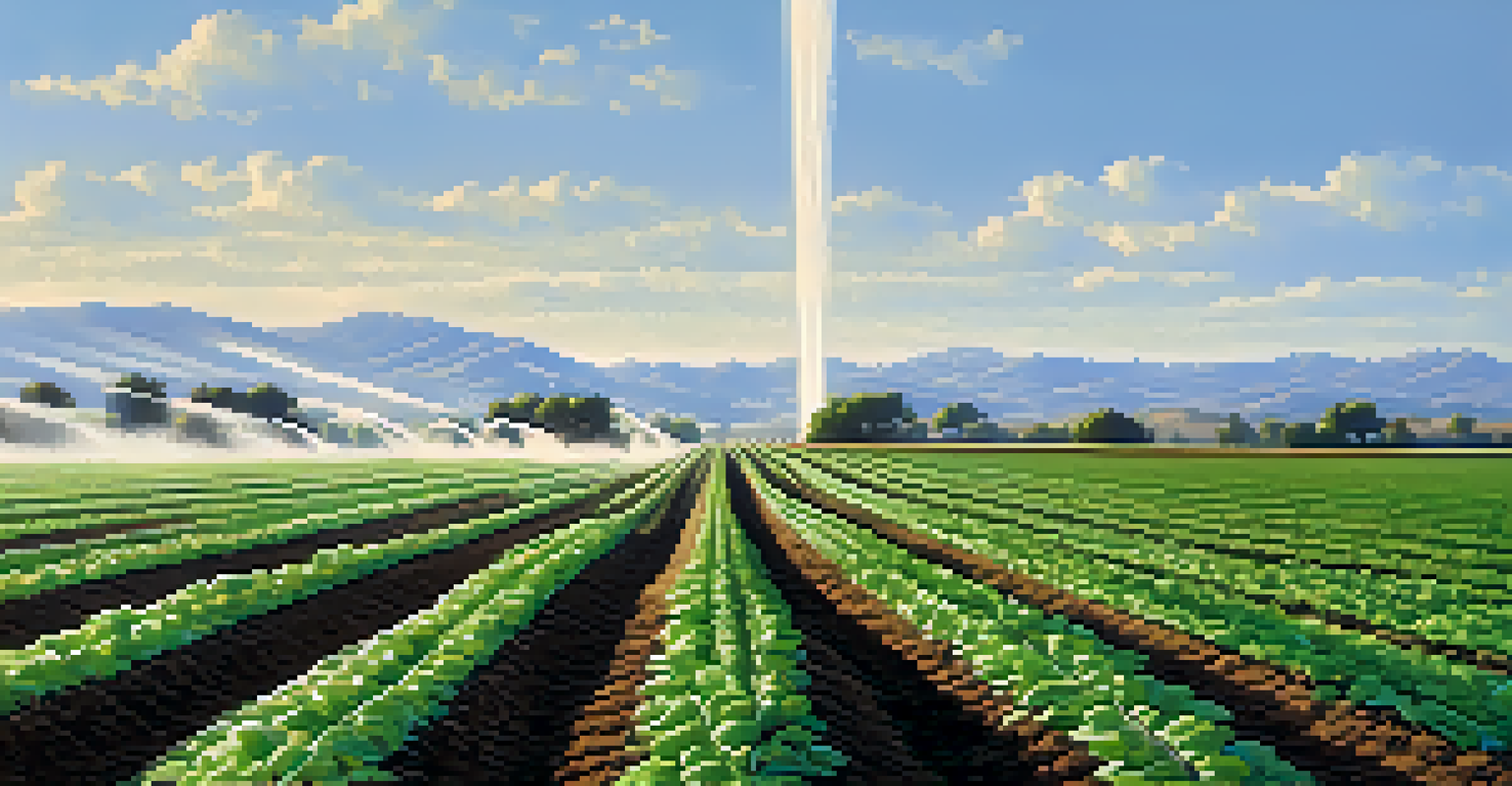The Role of Water in Plant Behavior and Environmental Response

Water: The Lifeblood of Plants and Their Growth
Water is often referred to as the lifeblood of plants, essential for their growth and survival. It plays a critical role in photosynthesis, the process through which plants convert sunlight into energy. Without sufficient water, plants struggle to perform this vital function, leading to stunted growth and reduced vitality.
Water is the driving force of all nature.
Moreover, water facilitates nutrient uptake from the soil, allowing plants to absorb minerals and vitamins necessary for their development. Think of water as a delivery truck that transports these nutrients to the plant's cells, ensuring they receive everything they need to flourish. Without adequate water, this delivery system falters, impacting overall plant health.
Additionally, water helps maintain plant turgor pressure, which is crucial for structural integrity. This pressure keeps plants upright and helps them withstand external forces like wind and rain. As a result, a well-hydrated plant is not only healthier but also more resilient to environmental stressors.
How Water Affects Plant Responses to Environmental Changes
Plants respond to their environment in various ways, and water availability is a key factor in these adaptations. For instance, during periods of drought, many plants will initiate a series of physiological changes to conserve water, such as closing their stomata, the tiny openings on leaves. This action reduces water loss but also limits carbon dioxide intake, affecting photosynthesis.

In contrast, when water is abundant, plants often exhibit rapid growth and lush foliage. This can be likened to how we feel energized after a refreshing drink; plants thrive and expand when they have enough moisture. Such responses highlight the delicate balance plants must maintain in adapting to their water supply.
Water is Essential for Plant Growth
Water is crucial for photosynthesis, nutrient uptake, and maintaining plant structure, directly impacting their health and vitality.
Furthermore, certain plants have evolved unique adaptations to cope with varying water conditions. For example, succulents store water in their leaves, allowing them to survive in arid environments. These adaptations showcase the incredible versatility of plants and their ability to respond to the ever-changing conditions of their surroundings.
The Role of Water in Plant Communication
Believe it or not, plants can 'talk' to each other, and water plays a significant role in this communication. When plants experience stress—such as from drought—they can release volatile organic compounds (VOCs) into the air to signal neighboring plants. This warning allows nearby plants to prepare for similar stress, adjusting their water usage and other responses accordingly.
The plant is the only living thing that can convert sunlight into food, but it needs water to do so.
Additionally, water serves as a medium for chemical signaling through root systems. Plants can release exudates into the soil, which can then be sensed by nearby plants, leading to collective responses in the face of environmental challenges. This phenomenon is akin to a neighborhood watch alerting residents about potential dangers.
Through this interconnected web of communication, plants can enhance their survival rates and adapt more effectively to their environment. It’s a fascinating reminder of how life on Earth is intricately linked, with water acting as a vital link in these interactions.
Water Management: A Key to Sustainable Agriculture
Sustainable agriculture heavily relies on effective water management practices. Farmers need to understand how much water their crops require and when to deliver it to optimize growth and yield. This balance is crucial, as overwatering can lead to root rot, while underwatering can cause stress and reduced harvests.
Implementing techniques like drip irrigation allows for precise water delivery directly to the plant roots, minimizing waste and promoting efficiency. Such methods not only conserve water but also enhance crop resilience, ensuring that plants receive the moisture they need without excess.
Climate Change Affects Water Supply
Rising temperatures and shifting precipitation patterns due to climate change threaten water availability, disrupting plant growth cycles and ecosystems.
Moreover, understanding the water needs of different plant species can lead to more effective crop rotation and diversification strategies. By selecting plants that thrive under similar water conditions, farmers can create a more sustainable ecosystem that reduces water consumption and maximizes productivity.
The Impact of Climate Change on Water Availability
Climate change poses significant challenges to water availability, impacting plant behavior and growth patterns. As temperatures rise and precipitation patterns shift, many regions are experiencing more frequent and severe droughts. This not only affects water supply but also alters the timing of plant growth cycles, disrupting the natural balance of ecosystems.
In response to these changes, some plants may adapt by shifting their growing seasons or altering their water usage strategies. For instance, certain species are beginning to bloom earlier in the spring as they respond to warmer temperatures. This shift can lead to mismatches between plants and their pollinators, affecting reproduction and survival.
Furthermore, the increased variability in rainfall can lead to more intense flooding in some areas, which can drown plants or wash away vital topsoil. This dynamic interplay between climate change and water availability underscores the importance of proactive measures to protect both plants and the environments they inhabit.
Water's Role in Plant Disease Resistance
Water availability can significantly influence a plant's ability to resist diseases. When plants are well-hydrated, they maintain stronger cell walls and healthier tissues, making it more difficult for pathogens to infiltrate. Conversely, stressed plants, often due to drought, are more susceptible to diseases, as their defenses are weakened.
Moreover, adequate water promotes the growth of beneficial microorganisms in the soil, which can help combat harmful pathogens. These beneficial microbes form symbiotic relationships with plant roots, enhancing nutrient uptake and improving overall plant health. Think of it as having a team of allies working tirelessly to protect the plant.
Innovative Water Conservation Techniques
New technologies and methods, such as soil moisture sensors and rainwater harvesting, are transforming water management practices for healthier plants.
In contrast, overwatering can create conditions conducive to root rot and other diseases, illustrating the need for balance. Understanding the relationship between water management and plant health is crucial for both home gardeners and agricultural professionals aiming to keep their plants thriving.
Innovations in Water Conservation for Plant Care
Innovations in water conservation are transforming how we approach plant care. Technologies such as soil moisture sensors can help gardeners and farmers monitor water levels in real-time, allowing for more precise irrigation. This not only conserves water but also ensures plants receive the optimal amount they need to thrive.
Additionally, techniques like rainwater harvesting are becoming increasingly popular, enabling homeowners to collect and store rainwater for later use in gardens. This eco-friendly practice not only reduces dependence on municipal water supplies but also promotes sustainable gardening habits.

As we continue to face challenges related to water availability, adopting innovative practices will be essential for maintaining healthy plants and ecosystems. By embracing new technologies and methods, we can ensure that water remains a valuable resource for generations to come.